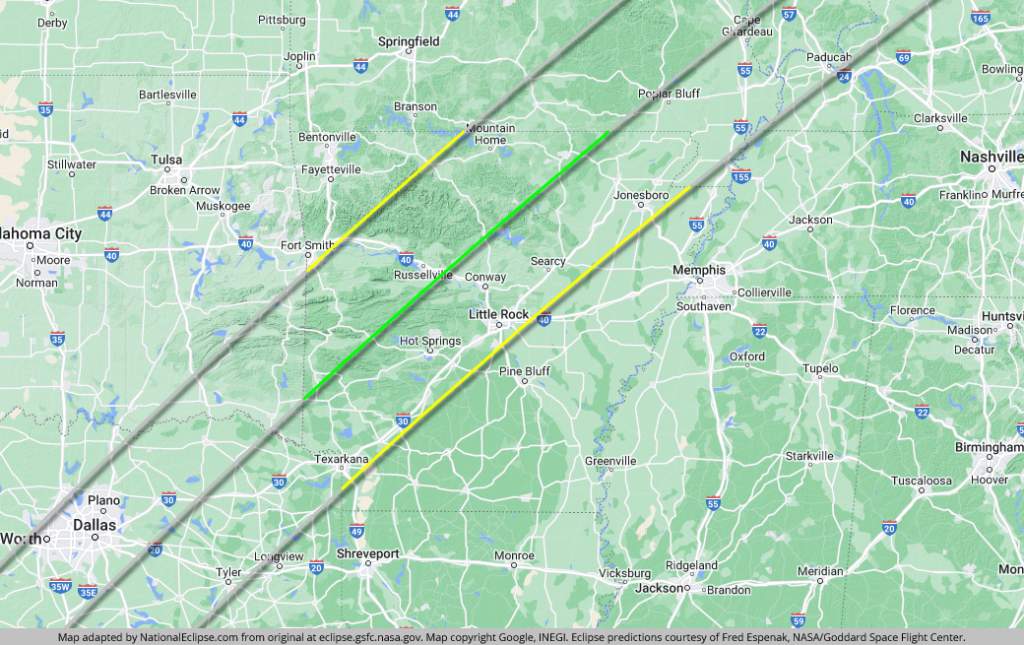A total solar eclipse happens when the Moon passes between the Sun and Earth, completely blocking the face of the Sun. People viewing the eclipse from locations where the Moon’s shadow completely covers the Sun – known as the path of totality – will experience a total solar eclipse. The sky will become dark as if it were dawn or dusk.
To see all stages of a total solar eclipse, you must view it from somewhere along the path of totality: the locations on Earth from which the Moon’s shadow completely covers the Sun. Little Rock, AR, is in this path, and the University of Arkansas at Little Rock will host an exciting and informative event for the community.
Map of Eclipse Totality in Arkansas
 source: nationaleclipse.com
source: nationaleclipse.com
Eclipse Resources
General Information
- 2024 Total Solar Eclipse – NASA
- Everything You Need to Know About the 2024 Total Solar Eclipse – Smithsonian
- Solar Eclipse Eye Safety – American Academy of Ophthalmology
- Solar Eclipse Across America – American Astronomical Association
Solar Eclipses in History
- Solar Eclipse of 1834 – Encyclopedia of Arkansas
- Solar Eclipse of 1918 – Encyclopedia of Arkansas
- Eclipse History – Newspaper Archive – NASA
- Solar eclipse represented in the petroglyphs of Vigirima (Venezuela) – Nelson Falcón, 2013
Human experiences
- The Sun and Us – Exploratorium
- Chasing Shadows: A Photographer Captures Solar Eclipses Around the World – Documentary about photographer and astronomer Geoff Sims, who travels the globe capturing solar eclipses. Available on Kanopy *requires UALR login
- Eclipse Stories from Around the World – Exploratorium
- Making Music from a Solar Eclipse – Exploratorium
Astronomy
- Solar eclipses as an astrophysical laboratory – Jay M. Pasachoff, 2009 *Requires UALR login
- Eclipse Prediction on the Ancient Greek Astronomical Calculating Machine Known as the Antikythera Mechanism – Tony Freeth, 2014
- Determining the Saros – Astronomical League
- Eclipse across America: Citizen Science Observations of the 21 August 2017 Total Solar Eclipse – Brant Dodson, Marilé Colón Robles, Jessica E. Taylor, Cayley C. DeFontes, Kristen L. Weaver, 2019
Impact on animals
- Total Eclipse of the Zoo: Animal Behavior during a Total Solar Eclipse – Adam Hartstone-Rose, Edwin Dickinson, Lisa M. Paciulli, Ashley R. Deutsch, Leon Tran, Grace Jones, Kaitlyn C. Leonard, 2020
- Observations on the Behavior of Animals during the Total Solar Eclipse of August 31, 1932 – William Morton Wheeler, Clinton V. MacCoy, Ludlow Griscom, Glover M. Allen, Harold J. Coolidge Jr., 1935 *Requires UALR login
- Disruption in honey bee (Apis mellifera) foraging flight activity during a partial solar eclipse shown by individual flight path tracking – Bryan C. Hains, Heather Gamper, 2017
- Comparing Social Media Observations of Animals During a Solar Eclipse to Published Research – Robert Ritson, Dustin H. Ranglack, and Nate Bickford, 2019
Art
- Howard Russell Butler: Painter Extraordinary of Solar Eclipses – Rolf M. Sinclair, 2012
- Perception of Solar Eclipses Captured by Art Explains How Imaging Misrepresented the Source of the Solar Wind – Richard Woo, 2015
- Art of the eclipse – Jay M. Pasachoff, Roberta J.M. Olson, 2014
- Eclipses in Art – Princeton University Art Museum
Resources for K-12 Students and Teachers
- The Solar Eclipse That Validated Einstein’s Theory of Relativity – Frontiers for Young Minds
- What is a Solar Eclipse? – NASA
- Eclipse – National Geographic
- Our Place in the Universe, Sun, Earth, Moon, Eclipses Activity Guide – NASA